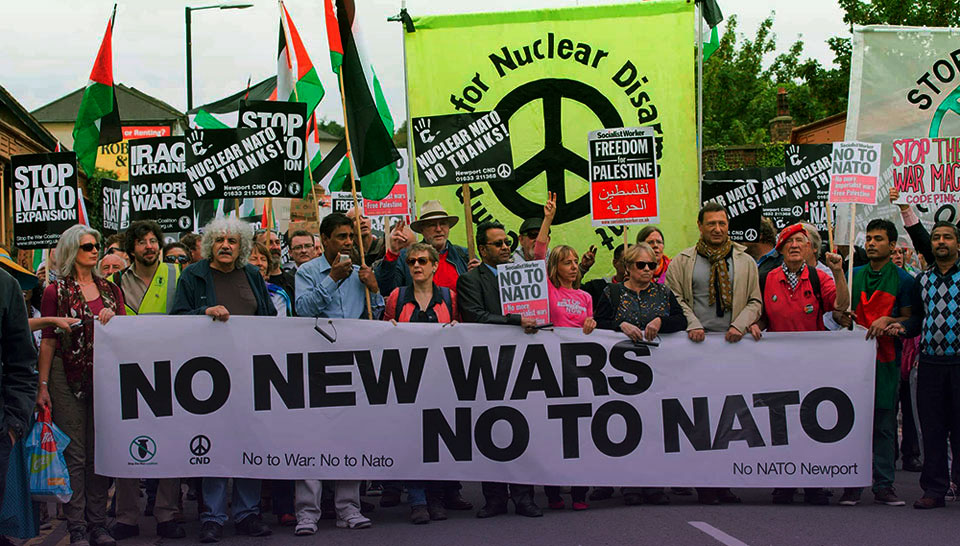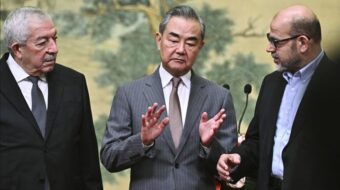
NATO, the international arm of the Pentagon, is in the news these days because of its role in the war in Ukraine. For now, millions in the U.S. see it as charting a path that can end that war and bring about peace. This false perception results from a truly unprecedented, 24-hour propaganda blitz to which the people of the U.S. are being subjected.
While NATO is close to having expanded throughout all of Europe, right up to the borders of Russia, less noticed is its additional expansion now around the world.
A major question that has to be answered is whether NATO’s expansion and its continued pumping of weapons into the war in Ukraine and other wars around the world is the path to world peace.
Less talked about than Ukraine are other wars going on right now in Palestine, Syria, Yemen, and Somalia. In all of them, a dangerous nuclear-armed NATO is a factor. NATO is not a committee with an office on a tree-lined street in Brussels somewhere. It is essentially an extension of the Pentagon, a global outfit armed to the teeth with nuclear weapons that pushes the policies of U.S. imperialism on people everywhere.
Since NATO’s inception after World War II, peace movements here and across Europe have opposed its expansion. The need today is for that opposition to continue, despite attempts by some to push the peace movements off course.
One would not know it from coverage in the corporate media, but there is pushback by a peace movement that, while it is small and divided in places like the United States, is growing in other places around the world.
There has long been a need for a vibrant peace movement around the globe. That need increased dramatically in the 1990s when the Pentagon, through NATO, decided it needed to station a new generation of nuclear missiles in Europe. That decision was part of the Pentagon’s claim that what was needed to preserve democracy was its new missile defense system, which had been under development for years. No more “Mutually Assured Destruction,” the Pentagon was saying. The U.S. wanted a system that could defend against any and all nuclear missile attacks, and the new missiles it was placing in Europe, it said, would do just that. Prior to that time, the world relied on fear of mutual annihilation to prevent nuclear war between the U.S. and the Soviet Union. Now, supposedly, it could rely on a wonderful new generation of U.S. missiles to do the trick.

While the Pentagon, through NATO, was blessing Europe with the deployment of “peacekeeping” nuclear missiles, it began its first round of expansions which, after the Cold War, it had promised never to do. The result of that expansion was reflected as soon as the military alliance started the bombing and destruction of Yugoslavia.
It was officially the end of the new world of peace and happiness that was supposed to be ushered in by a Pax Americana via the Pentagon and NATO after the demise of the socialist countries in Europe. It was instead, for Europe, the beginning of a more militarized period of tension, conflict, and war—something Europe had not seen since 1945. It was the end of nearly 50 years of peace in Europe, a peace pursued by the socialist countries, and a peace, the length of which had not been seen in the entire history of the continent.
Peace offensive
Peace movements in the U.S. were actually mobilizing against Pentagon threats as early as the 1950s when they opposed massive nuclear bomb testing in the air—testing of bombs that were a thousand times more powerful than those dropped on Hiroshima and Nagasaki.
Women played a leading role in those movements, as noted in one popular Hollywood film, The Way We Were, starring Barbra Streisand. While school children were ducking under their desks to protect against non-existent nuclear salvos from the Soviet Union, women across the country were fighting to end the harmful effects of bomb testing and radiation on their children. They said “No” to the irradiated milk many children and babies in the U.S. were drinking. It was the mobilization of peace forces that curbed the deadly practices of the Pentagon in those days.
From that time onward, the peace movements always came forward to fight the good fight for peace and justice, whether it was in the struggle to end the colonial wars and domination in Latin America, the wars in Korea and Vietnam, or countless other wars.
The anti-nuclear weapons movement has always been among the strongest and most important currents in the peace movement, both in the U.S. and around the world. It needs to grow exponentially once again to counter the dangers posed by modern-day Pentagon-NATO exploits.
Today, the peace movement in the U.S is said to be having a hard time getting its act together. If history is any guide, however, it is only a matter of time before it does that and joins hands with an international peace movement that is taking on NATO all over the world. The nation’s capital, and the White House itself, have already been the site of vigorous anti-war protests led by groups like CodePink and others. Those movements have rightly taken aim at NATO’s share of responsibility for getting the world into this war.
Why it’s important to oppose NATO
Why is it necessary for peace forces to challenge NATO’s role in Ukraine and other wars today, and to challenge NATO’s plan to expand around the world? The answer is that the “alliance” is as committed to militarism, war, and profits for weapons makers today as it was back in the days of those first anti-nuclear bomb protests. And today, it is even worse because NATO has access to far more powerful and dangerous nuclear weapons than it had back then.
At the end of the Cold War, the Warsaw Pact, which was the defensive alliance of the socialist countries, was dissolved. Rather than dissolve NATO and develop a new kind of security arrangement encompassing everyone in Europe to begin the work of developing a truly new and peaceful world order, the decision was made in Washington to maintain and increase the strength and power of NATO.
NATO was not only maintained; it expanded in a number of tsunami waves staggered over a period of years from the late 1990s up to the present day. The peace movements everywhere were opposed because it meant the deployment of more dangerous weapons. It meant bringing more and more countries into a dangerous nuclear-armed pact controlled by the Pentagon.
When the alleged reason for its existence (protection against an attack from the Soviet Union that never came) vanished, the Pentagon decided it was in the perfect position to continue anyway and step up its battles to impose imperialist aims everywhere, even outside of Europe.
In 2001, under NATO’s umbrella, European countries joined the U.S. war on Afghanistan, a country far away from Europe. That move was essentially a declaration that NATO was now a global alliance controlled by the Pentagon and the U.S.
Today, there is a lot of talk that NATO is defending the sovereignty of Ukraine and other countries when it, in fact, undermines the sovereignty of even its own members by specifying how much they must spend on their own military budgets, often at the expense of social programs and infrastructure needs in those countries. Member countries are also required to open themselves to the traffic of heavy weaponry or to allow nuclear missiles to be stationed within their borders.
And the expansion up to the borders of Russia is not the end of NATO’s plans. At the last NATO summit, it was made clear that the next target is China. Leaders talked about how they are orienting the alliance toward the Pacific to “contain” China, which they see as a hostile power.
In addition to the planned moves against China, NATO is forming partnerships in Latin America and Africa too, in their quest, no doubt, to “protect democracy.”
No room for error
With this history and with the direction it is taking, there should be little expectation that NATO is going to bring about any good results for people suffering and dying in Ukraine. The course of more troops, more weapons, and more war is not the answer.
A ceasefire, followed by the withdrawal of Russian troops, then negotiations around new security guarantees is the only way to go when it comes to the war in Ukraine. Any other path, especially the one espoused by the Pentagon and NATO, will result only in more war and more death.
Perhaps the worst danger of continuing on the nuclear-armed NATO path is that one way or the other we will end up in an unthinkable nuclear war. There are almost 20,000 nuclear bombs in the world, each one more powerful than the ones that destroyed Hiroshima and Nagasaki. Given this danger, who could possibly want to see a continuation of NATO expansion around the world?
The growth of NATO has always been and—under the circumstances of today’s wars in Ukraine and elsewhere—still is something the peace movement must oppose. Throughout history, humanity has been able to come back from and fix many of our mistakes, but we can never come back from a nuclear war.
As with all op-eds published by People’s World, the opinions reflected here are solely those of the author.












Comments